brake fluid VOLVO XC70 2003 Owners Manual
[x] Cancel search | Manufacturer: VOLVO, Model Year: 2003, Model line: XC70, Model: VOLVO XC70 2003Pages: 257, PDF Size: 5.33 MB
Page 33 of 257
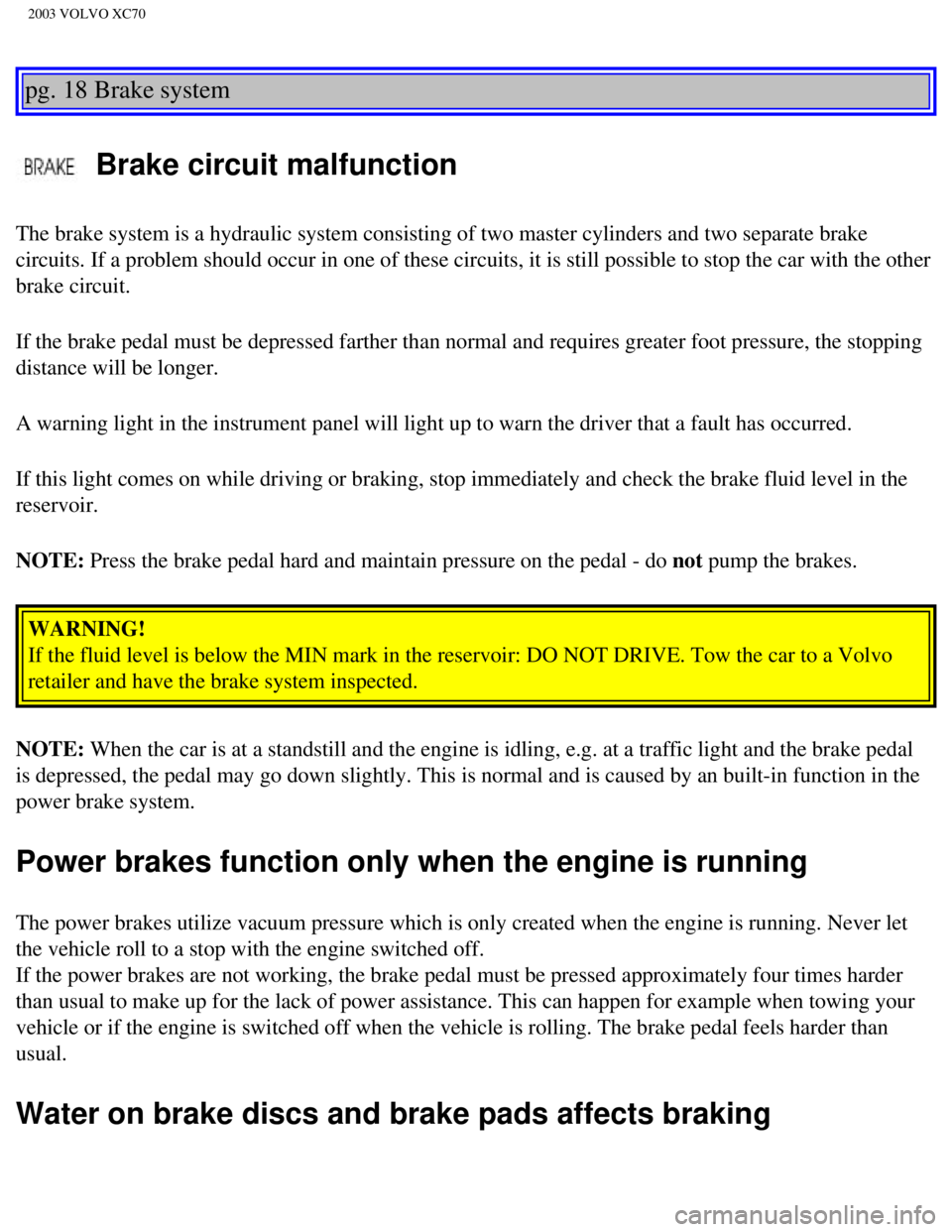
2003 VOLVO XC70
pg. 18 Brake system
Brake circuit malfunction
The brake system is a hydraulic system consisting of two master cylinder\
s and two separate brake
circuits. If a problem should occur in one of these circuits, it is stil\
l possible to stop the car with the other
brake circuit.
If the brake pedal must be depressed farther than normal and requires gr\
eater foot pressure, the stopping
distance will be longer.
A warning light in the instrument panel will light up to warn the driver\
that a fault has occurred.
If this light comes on while driving or braking, stop immediately and ch\
eck the brake fluid level in the
reservoir.
NOTE: Press the brake pedal hard and maintain pressure on the pedal - do not pump the brakes.
WARNING!
If the fluid level is below the MIN mark in the reservoir: DO NOT DRIVE.\
Tow the car to a Volvo
retailer and have the brake system inspected.
NOTE: When the car is at a standstill and the engine is idling, e.g. at a traf\
fic light and the brake pedal
is depressed, the pedal may go down slightly. This is normal and is caus\
ed by an built-in function in the
power brake system.
Power brakes function only when the engine is running
The power brakes utilize vacuum pressure which is only created when the \
engine is running. Never let
the vehicle roll to a stop with the engine switched off.
If the power brakes are not working, the brake pedal must be pressed app\
roximately four times harder
than usual to make up for the lack of power assistance. This can happen \
for example when towing your
vehicle or if the engine is switched off when the vehicle is rolling. Th\
e brake pedal feels harder than
usual.
Water on brake discs and brake pads affects braking
file:///K|/ownersdocs/2003/2003_XC70/03xc70_01b.htm (10 of 14)12/30/20\
06 4:17:52 PM
Page 35 of 257
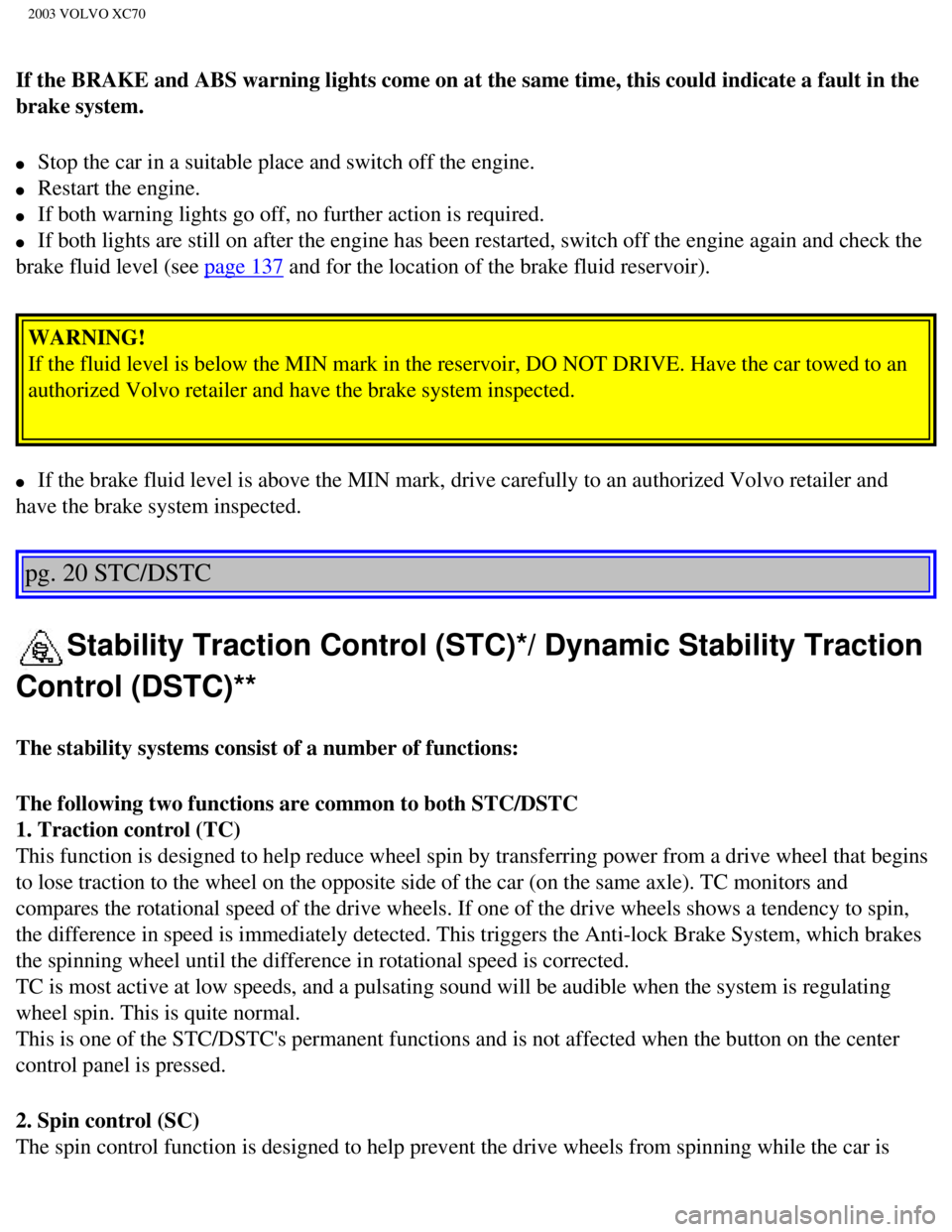
2003 VOLVO XC70
If the BRAKE and ABS warning lights come on at the same time, this could\
indicate a fault in the
brake system.
l Stop the car in a suitable place and switch off the engine.
l Restart the engine.
l If both warning lights go off, no further action is required.
l If both lights are still on after the engine has been restarted, switch \
off the engine again and check the
brake fluid level (see
page 137 and for the location of the brake fluid reservoir).
WARNING!
If the fluid level is below the MIN mark in the reservoir, DO NOT DRIVE.\
Have the car towed to an
authorized Volvo retailer and have the brake system inspected.
l If the brake fluid level is above the MIN mark, drive carefully to an au\
thorized Volvo retailer and
have the brake system inspected.
pg. 20 STC/DSTC
Stability Traction Control (STC)*/ Dynamic Stability Traction
Control (DSTC)**
The stability systems consist of a number of functions:
The following two functions are common to both STC/DSTC
1. Traction control (TC)
This function is designed to help reduce wheel spin by transferring powe\
r from a drive wheel that begins
to lose traction to the wheel on the opposite side of the car (on the s\
ame axle). TC monitors and
compares the rotational speed of the drive wheels. If one of the drive w\
heels shows a tendency to spin,
the difference in speed is immediately detected. This triggers the Anti-\
lock Brake System, which brakes
the spinning wheel until the difference in rotational speed is corrected\
.
TC is most active at low speeds, and a pulsating sound will be audible w\
hen the system is regulating
wheel spin. This is quite normal.
This is one of the STC/DSTC's permanent functions and is not affected wh\
en the button on the center
control panel is pressed.
2. Spin control (SC)
The spin control function is designed to help prevent the drive wheels f\
rom spinning while the car is
file:///K|/ownersdocs/2003/2003_XC70/03xc70_01b.htm (12 of 14)12/30/20\
06 4:17:52 PM
Page 44 of 257
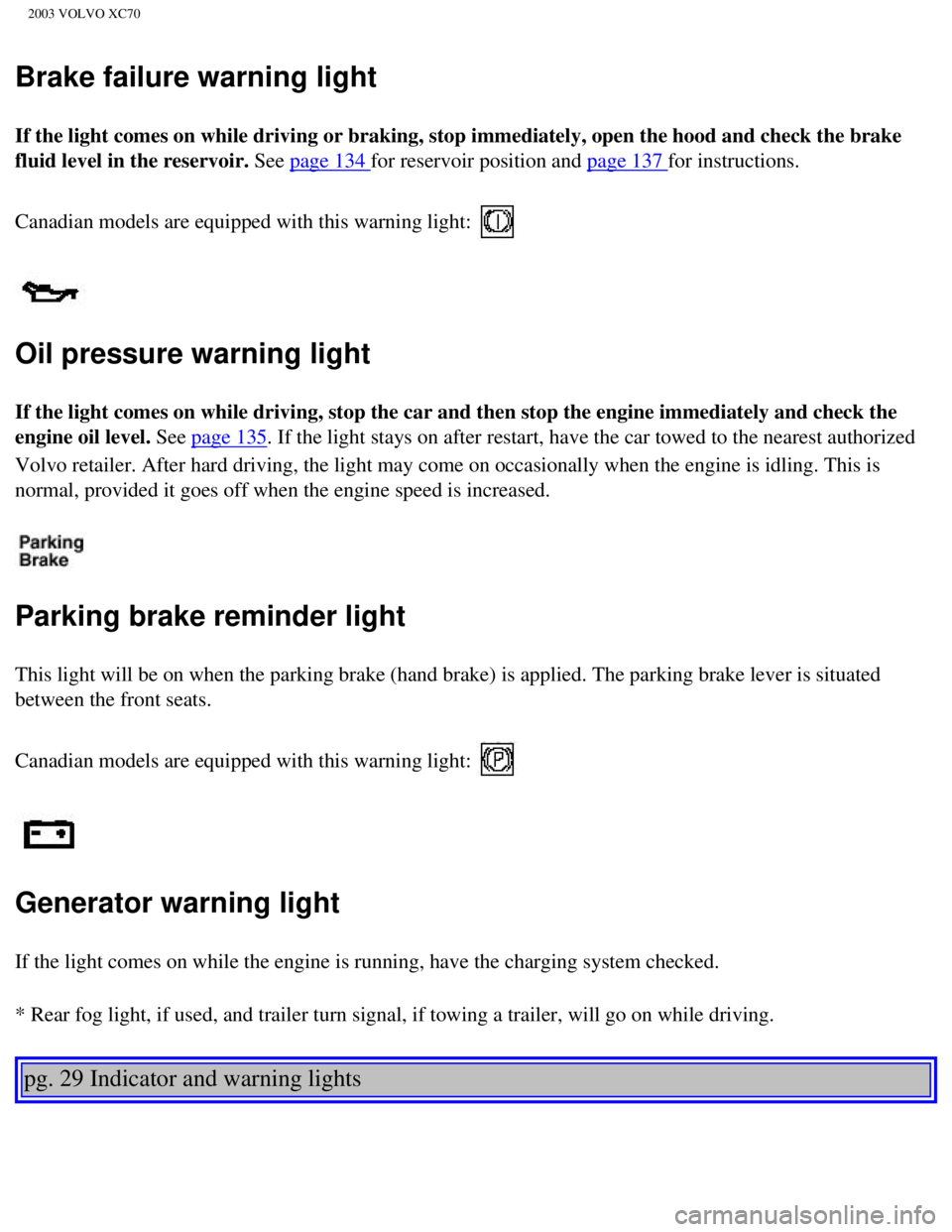
2003 VOLVO XC70
Brake failure warning light
If the light comes on while driving or braking, stop immediately, open t\
he hood and check the brake
fluid level in the reservoir. See
page 134 for reservoir position and page 137 for instructions.
Canadian models are equipped with this warning light:
Oil pressure warning light
If the light comes on while driving, stop the car and then stop the engi\
ne immediately and check the
engine oil level. See
page 135. If the light stays on after restart, have the car towed to the nearest\
authorized
Volvo retailer. After hard driving, the light may come on occasionally w\
hen the engine is idling. This is
normal, provided it goes off when the engine speed is increased.
Parking brake reminder light
This light will be on when the parking brake (hand brake) is applied. \
The parking brake lever is situated
between the front seats.
Canadian models are equipped with this warning light:
Generator warning light
If the light comes on while the engine is running, have the charging sys\
tem checked.
* Rear fog light, if used, and trailer turn signal, if towing a trailer,\
will go on while driving.
pg. 29 Indicator and warning lights
file:///K|/ownersdocs/2003/2003_XC70/03xc70_02a.htm (7 of 13)12/30/200\
6 4:17:53 PM
Page 129 of 257
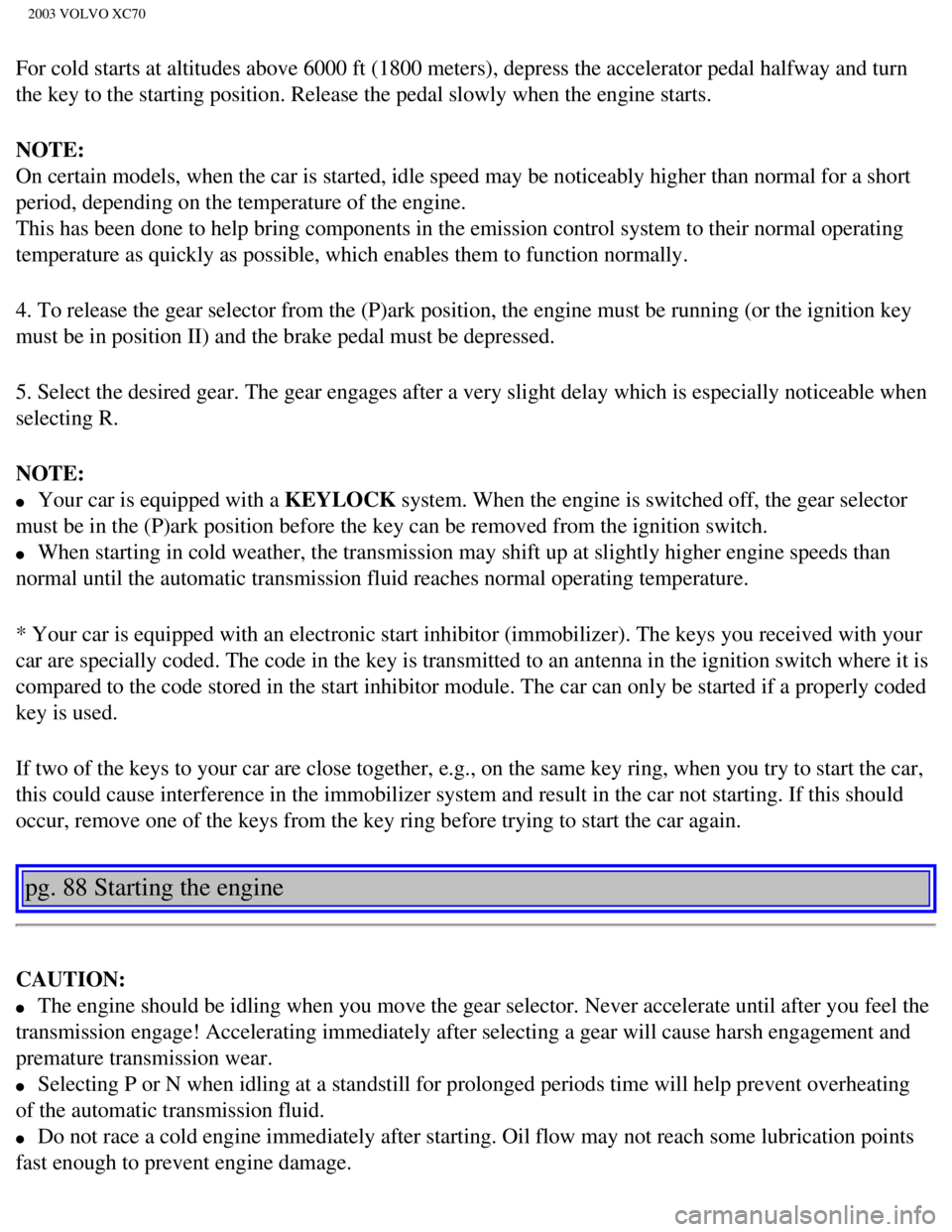
2003 VOLVO XC70
For cold starts at altitudes above 6000 ft (1800 meters), depress the \
accelerator pedal halfway and turn
the key to the starting position. Release the pedal slowly when the engi\
ne starts.
NOTE:
On certain models, when the car is started, idle speed may be noticeably\
higher than normal for a short
period, depending on the temperature of the engine.
This has been done to help bring components in the emission control syst\
em to their normal operating
temperature as quickly as possible, which enables them to function norma\
lly.
4. To release the gear selector from the (P)ark position, the engine m\
ust be running (or the ignition key
must be in position II) and the brake pedal must be depressed.
5. Select the desired gear. The gear engages after a very slight delay w\
hich is especially noticeable when
selecting R.
NOTE:
l Your car is equipped with a KEYLOCK system. When the engine is switched off, the gear selector
must be in the (P)ark position before the key can be removed from the \
ignition switch.
l When starting in cold weather, the transmission may shift up at slightly\
higher engine speeds than
normal until the automatic transmission fluid reaches normal operating t\
emperature.
* Your car is equipped with an electronic start inhibitor (immobilizer)\
. The keys you received with your
car are specially coded. The code in the key is transmitted to an antenn\
a in the ignition switch where it is
compared to the code stored in the start inhibitor module. The car can o\
nly be started if a properly coded
key is used.
If two of the keys to your car are close together, e.g., on the same key\
ring, when you try to start the car,
this could cause interference in the immobilizer system and result in th\
e car not starting. If this should
occur, remove one of the keys from the key ring before trying to start t\
he car again.
pg. 88 Starting the engine
CAUTION:
l The engine should be idling when you move the gear selector. Never accel\
erate until after you feel the
transmission engage! Accelerating immediately after selecting a gear wil\
l cause harsh engagement and
premature transmission wear.
l Selecting P or N when idling at a standstill for prolonged periods time \
will help prevent overheating
of the automatic transmission fluid.
l Do not race a cold engine immediately after starting. Oil flow may not r\
each some lubrication points
fast enough to prevent engine damage.
file:///K|/ownersdocs/2003/2003_XC70/03xc70_06a.htm (6 of 22)12/30/200\
6 4:17:59 PM
Page 154 of 257

2003 VOLVO XC70
pg. 105 Long distance trips
Before a long distance trip
It is always worthwhile to have your car checked at a Volvo retailer bef\
ore driving long distances. Your
retailer will also be able to supply you with bulbs, fuses, spark plugs \
and wiper blades for your use in the
event that problems occur.
As a minimum, the following items should be checked before any long trip\
:
l Check that engine runs smoothly and that fuel consumption is normal.
l Check for fuel, oil, and fluid leakage.
l Check condition of accessory drive belts.
l Check transmission oil level*.
l Check state of the battery's charge.
l Examine tires carefully (the spare tire as well), and replace those th\
at are worn. Check tire pressures.
l The brakes, front wheel alignment, and steering gear should be checked b\
y your Volvo retailer only.
l Check all lights, including high beams.
l Reflective warning triangles are legal requirement in some countries.
l Have a word with your Volvo retailer if you intend to drive in countries\
where it may be difficult to
obtain the correct fuel.
l Consider your destination. If you will be driving through an area where \
snow or ice are likely to
occur, consider snow tires.
* To prevent injury from contact with hot surfaces, do not inspect your \
car's transmission fluid yourself.
Have your car's transmission fluid level inspected by a qualified Volvo \
service technician.
pg. 106 Three-way catalytic converters
file:///K|/ownersdocs/2003/2003_XC70/03xc70_06b.htm (9 of 10)12/30/200\
6 4:18:00 PM
Page 166 of 257
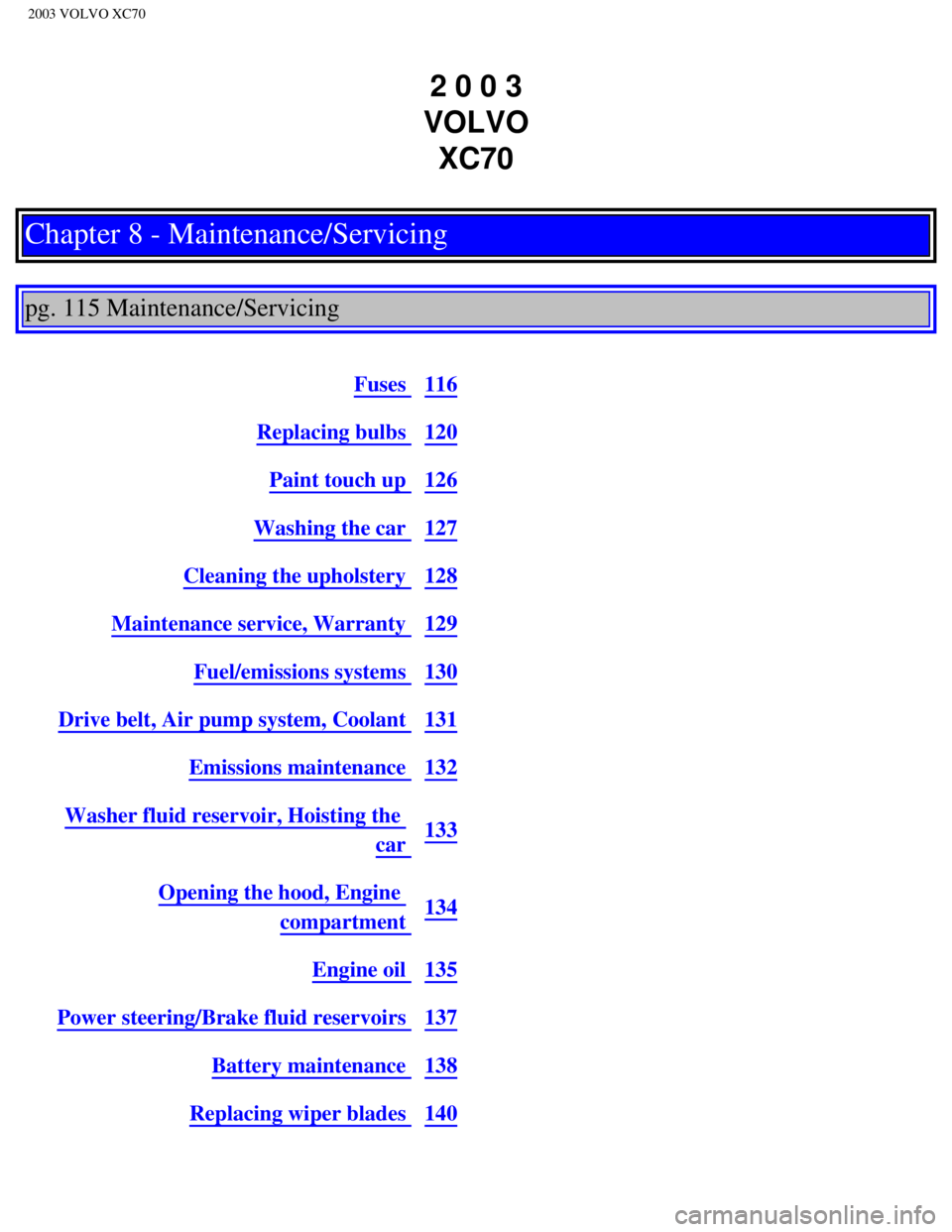
2003 VOLVO XC70
2 0 0 3
VOLVO XC70
Chapter 8 - Maintenance/Servicing
pg. 115 Maintenance/Servicing
Fuses 116
Replacing bulbs 120
Paint touch up 126
Washing the car 127
Cleaning the upholstery 128
Maintenance service, Warranty 129
Fuel/emissions systems 130
Drive belt, Air pump system, Coolant 131
Emissions maintenance 132
Washer fluid reservoir, Hoisting the
car 133
Opening the hood, Engine
compartment 134
Engine oil 135
Power steering/Brake fluid reservoirs 137
Battery maintenance 138
Replacing wiper blades 140
file:///K|/ownersdocs/2003/2003_XC70/03xc70_08a.htm (1 of 21)12/30/200\
6 4:18:03 PM
Page 193 of 257
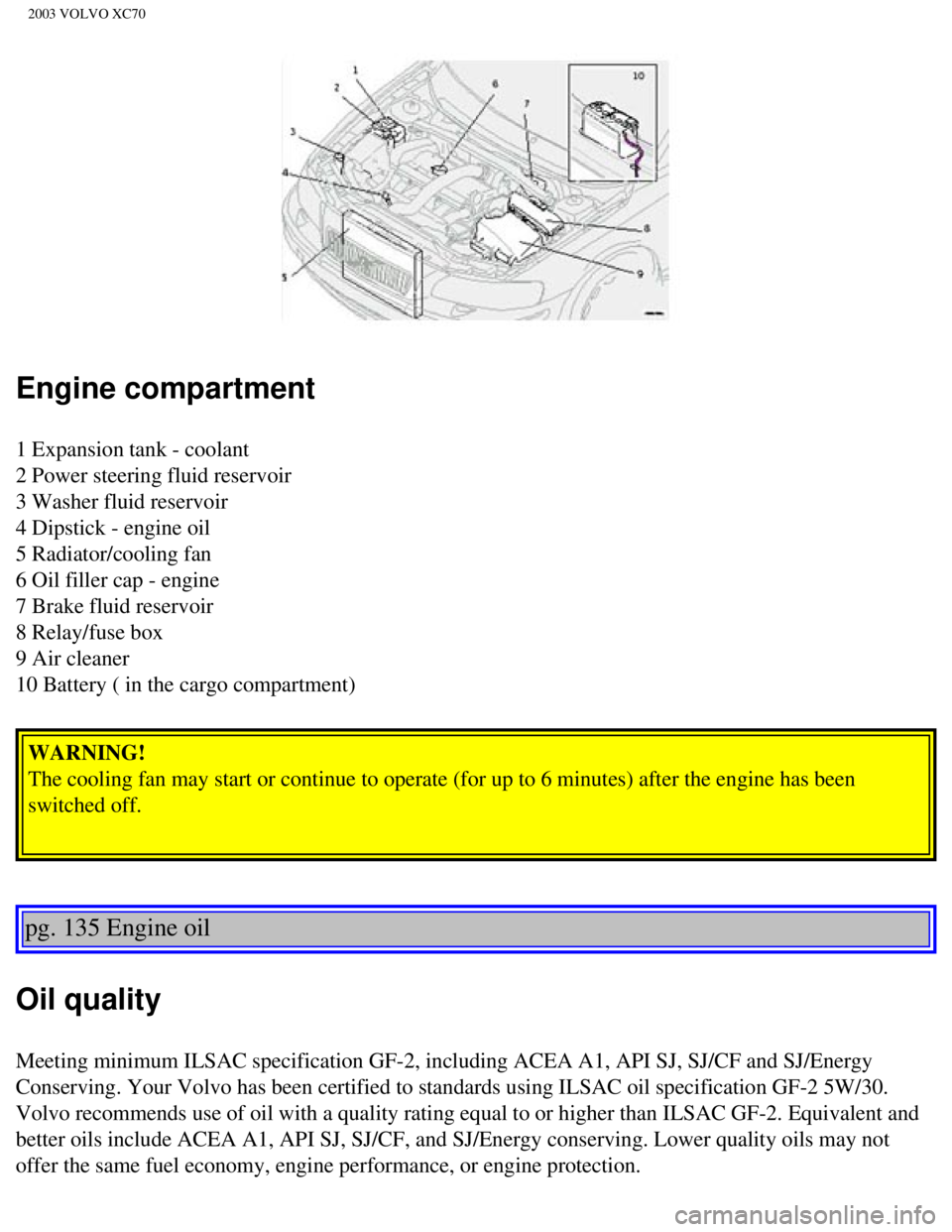
2003 VOLVO XC70
Engine compartment
1 Expansion tank - coolant
2 Power steering fluid reservoir
3 Washer fluid reservoir
4 Dipstick - engine oil
5 Radiator/cooling fan
6 Oil filler cap - engine
7 Brake fluid reservoir
8 Relay/fuse box
9 Air cleaner
10 Battery ( in the cargo compartment) WARNING!
The cooling fan may start or continue to operate (for up to 6 minutes)\
after the engine has been
switched off.
pg. 135 Engine oil
Oil quality
Meeting minimum ILSAC specification GF-2, including ACEA A1, API SJ, SJ/\
CF and SJ/Energy
Conserving. Your Volvo has been certified to standards using ILSAC oil s\
pecification GF-2 5W/30.
Volvo recommends use of oil with a quality rating equal to or higher tha\
n ILSAC GF-2. Equivalent and
better oils include ACEA A1, API SJ, SJ/CF, and SJ/Energy conserving. Lo\
wer quality oils may not
offer the same fuel economy, engine performance, or engine protection. \
file:///K|/ownersdocs/2003/2003_XC70/03xc70_08b.htm (7 of 16)12/30/200\
6 4:18:04 PM
Page 196 of 257
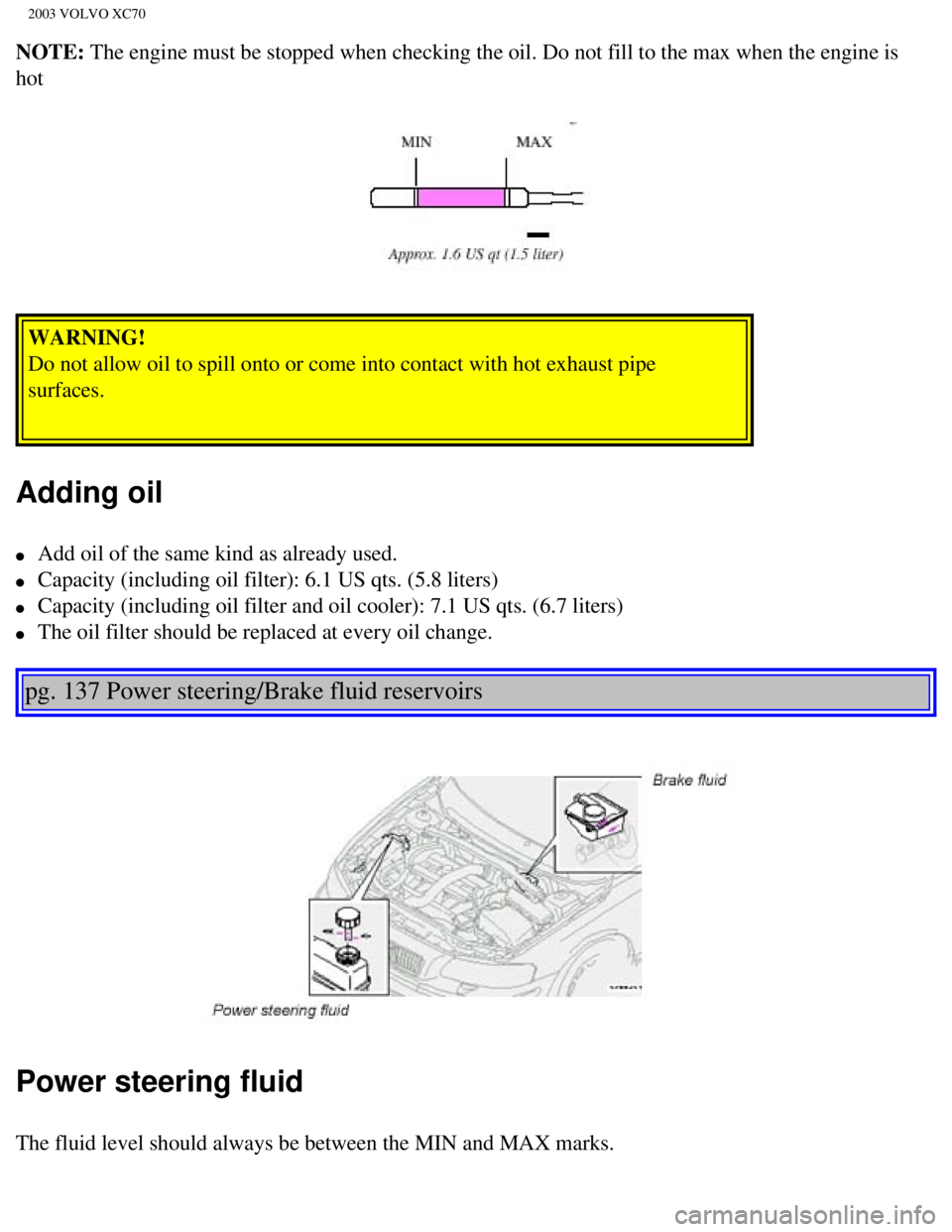
2003 VOLVO XC70
NOTE: The engine must be stopped when checking the oil. Do not fill to the max\
when the engine is
hot
WARNING!
Do not allow oil to spill onto or come into contact with hot exhaust pip\
e
surfaces.
Adding oil
l Add oil of the same kind as already used.
l Capacity (including oil filter): 6.1 US qts. (5.8 liters)
l Capacity (including oil filter and oil cooler): 7.1 US qts. (6.7 lite\
rs)
l The oil filter should be replaced at every oil change.
pg. 137 Power steering/Brake fluid reservoirs
Power steering fluid
The fluid level should always be between the MIN and MAX marks.
file:///K|/ownersdocs/2003/2003_XC70/03xc70_08b.htm (10 of 16)12/30/20\
06 4:18:04 PM
Page 197 of 257
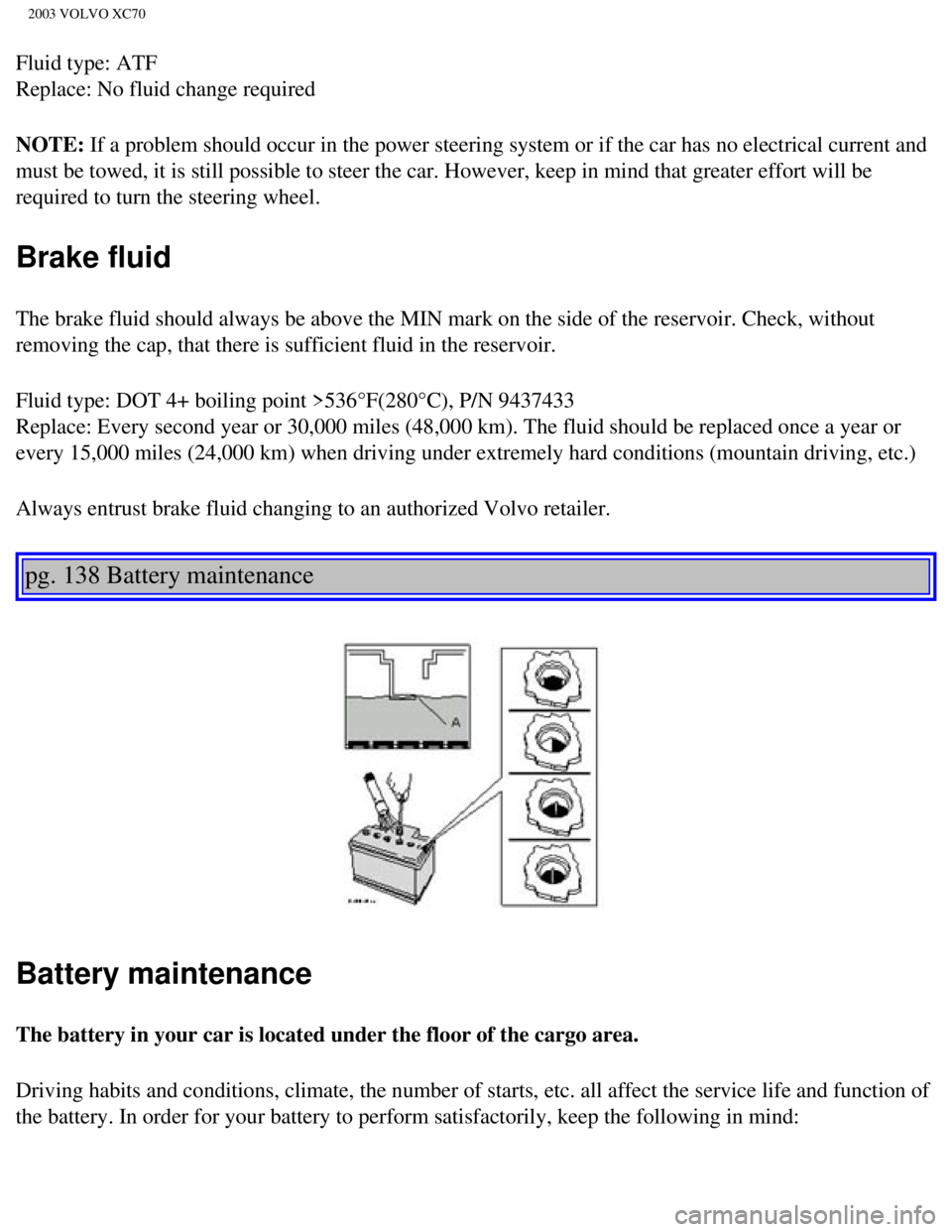
2003 VOLVO XC70
Fluid type: ATF
Replace: No fluid change required
NOTE: If a problem should occur in the power steering system or if the car ha\
s no electrical current and
must be towed, it is still possible to steer the car. However, keep in m\
ind that greater effort will be
required to turn the steering wheel.
Brake fluid
The brake fluid should always be above the MIN mark on the side of the r\
eservoir. Check, without
removing the cap, that there is sufficient fluid in the reservoir.
Fluid type: DOT 4+ boiling point >536°F(280°C), P/N 9437433
Replace: Every second year or 30,000 miles (48,000 km). The fluid shou\
ld be replaced once a year or
every 15,000 miles (24,000 km) when driving under extremely hard condi\
tions (mountain driving, etc.)
Always entrust brake fluid changing to an authorized Volvo retailer.
pg. 138 Battery maintenance
Battery maintenance
The battery in your car is located under the floor of the cargo area.
Driving habits and conditions, climate, the number of starts, etc. all a\
ffect the service life and function of
the battery. In order for your battery to perform satisfactorily, keep t\
he following in mind:
file:///K|/ownersdocs/2003/2003_XC70/03xc70_08b.htm (11 of 16)12/30/20\
06 4:18:04 PM
Page 210 of 257

2003 VOLVO XC70
Coolant: Volvo original coolant/antifreeze
All specifications are subject to change without prior notice.
Power steering fluid
ATF fluid
Volume: 0.95 US qts (0.9 liters)
Brake fluid
DOT 4+ boiling point >536°F(280°C), P/N 9437433
Volume: 0.64 US qts (0.6 liters)
Climate control system - refrigerant (R 134a)
Oil: PAG
Volume: 2.2 lbs (1,000 g) R134a
Fuel
Minimum octane requirement - AKI 87 (RON 91)
Volume (fuel tank): 18.5 US gals (70 liters) or 19 US gals (72 liters) on models equippe\
d with All
Wheel Drive.
Washer fluid reservoir
Volume: 4.7 US qts (4.5 liters)
All specifications are subject to change without prior notice.
pg. 147 Fuel system, Distributor ignition system, Suspension
Fuel system
The engine is equipped with a multiport fuel injection system.
file:///K|/ownersdocs/2003/2003_XC70/03xc70_09.htm (8 of 11)12/30/2006\
4:18:05 PM